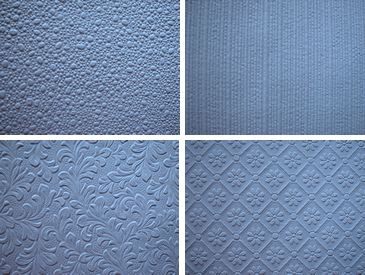In most cases, painting over wallpaper is a no-no. But with specially prepared paintable wallpapers, a coat of color can be your best friend.
Types of Paintable Papers
Paintable wall coverings have actually been around for a very long time. Lincrusta was invented in 1877 and is still the leading producer of this type of textured paintable wallpaper. Made from a combination of wood flour and linseed oil which is molded (not printed) onto a paper backing, it is very heavy and deeply textured. It’s best for hiding serious wall flaws, and is also used extensively in restoration of old buildings. It is extremely durable, perfect for high traffic areas, such as entryways and under chair rails.
Because it is so heavy, Lincrusta can be difficult to work with; you’ll need a helper. Lincrusta doesn’t bend – it cracks. Cut the material (from the back) to the exact size of the wall. You’ll have to fill any gaps at corners with spackling paste. Wipe the wall covering with mineral spirits, then prime with an oil based primer (acrylic and latex primers won’t adhere as well.)
A second type of paintable wallpaper, Anaglypta, is made using a combination of cotton and paper. It’s embossed to create a raised effect. Anaglypta is lighter in weight than Lincrusta, and hundreds of texture options are available. Although Anaglypta is a brand name, it has come to refer to all paintable wall coverings of this type.
Anagylpta is installed the same way traditional wallpapers are. The Armadillo line can be dry-hung, but others must be pasted, folded and soaked. One caveat: soak times must be exact to avoid uneven expansion. Prime Anaglypta papers with latex primer before painting.
The newest, and easiest to use, of the paintable wall coverings are the glass textiles. Created from fiberglass, these are breathable, fire resistant, and environmentally friendly. In addition, the fibers add a certain amount of stability to damaged walls, holding together small cracks and preventing crumbling. Damaged glass textile can be sanded smooth and repainted. Tassoglass and Textra are two popular brands.
Installation and Painting
Before installing glass textiles, remove any old wallpaper. Sand and prime painted finishes, and scrub paneling, brick, or concrete with Trisodium Phosphate (TSP). Cover right over small imperfections; they won’t show. Fill in deeper grooves on tile or masonry walls with a non-shrinking mud before papering.
Glass textiles come both primed and unprimed. Latex, enamel, or epoxy paints can be used, depending on your needs. Latex is more breathable and better in high moisture areas. Enamels and epoxies are highly cleanable and durable.
Fun Decorative Effects
Paintable wall coverings lend themselves especially well to decorative paint effects. Try laying down a base coat, followed by a darker glaze. Wipe off most of the glaze with a soft rag, leaving some in the deep recesses of the patten. Alternatively, after painting the basecoat, use a roller to highlight the raised areas with a lighter color. Faux finishes (like metal or leather) are fun, as are handpainted accents on friezes.
Some can even be left as is; the snowy white effect mimics plaster.
Advantages of Paintable Papers
Paintable papers combine the luxury of wallpaper with the changeability of paint. Once installed, these wall coverings can last up to 30 years and hold a dozen coats of paint without losing texture. Because of the raised pattern, textured paintable wallpapers lend an expensive “custom” look to any house.
Paintable papers are cheaper than drywall, making them a good alternative to replacing wood paneled walls, poorly textured drywall, or damaged areas. Because they are so strong, Lincrusta and glass textile can actually prevent further damage to crumbling walls. They also provide an economic alternative to expensive plaster moldings, and look almost indistinguishable from the real thing.
Paintable papers are more durable than other types of wallpaper. They are scrubbable and very resistant to tears and scratches.
Drawbacks of Paintable Wallpapers
Painted wallpaper is notoriously hard to remove. If you think you’ll tire of the texture quickly, this probably isn’t a good option for you.
Paintable wall coverings are expensive when compared to painting and most traditional wallpapers. It’s not the best option for saving money short-term.


